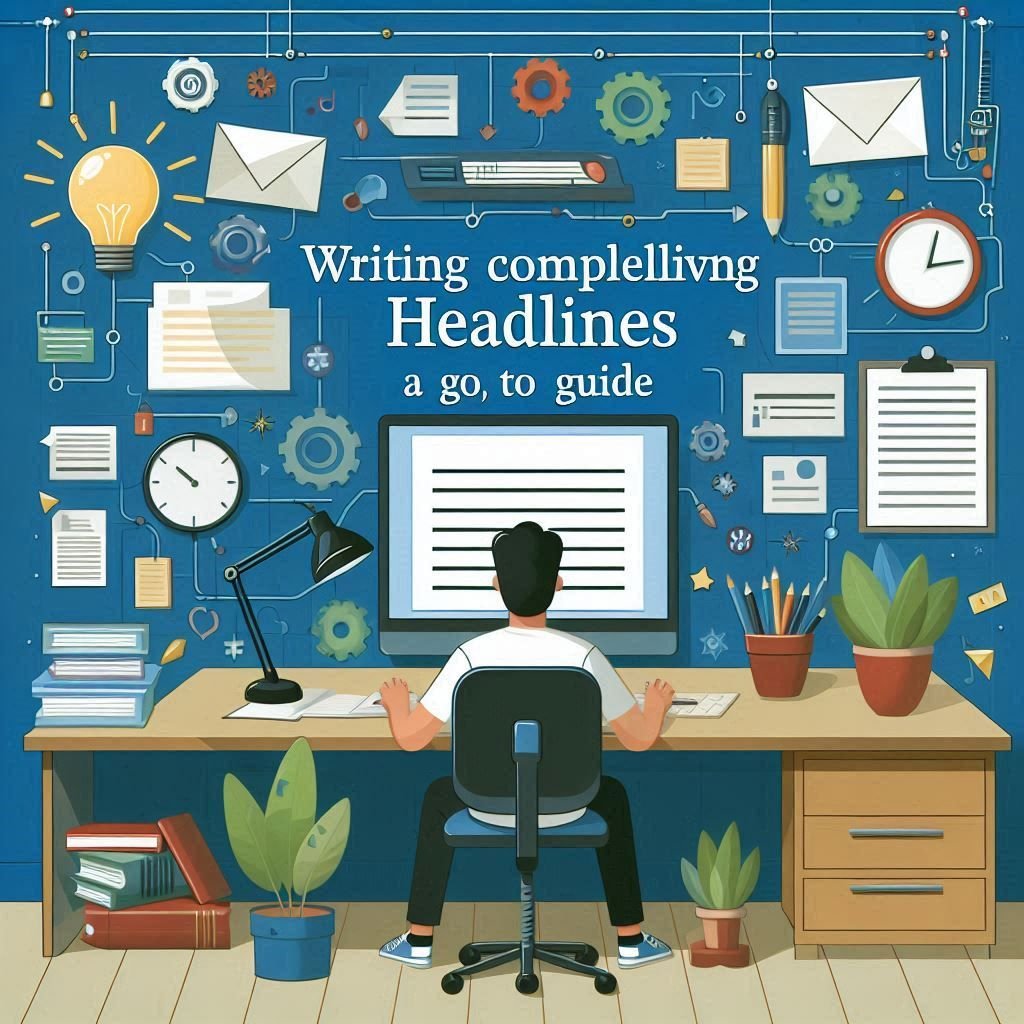Writing Compelling Headlines: A How-To Guide
The Importance of Compelling Headlines
Headlines are the first impression readers have of your content. A compelling headline can significantly increase your click-through rates and engagement. As noted by Neil Patel, headlines should grab attention, provoke curiosity, and convey the essence of the content in a few words.
1.Understanding Your Audience
Understanding your audience is a critical component of effective communication and marketing. By grasping the needs and preferences of your target demographic, you can tailor your content and strategies for maximum impact. According to American Express, businesses that prioritize audience understanding see enhanced customer satisfaction and loyalty.
Identifying Your Target Audience
To effectively engage with your audience, it’s essential to identify who they are. Utilize tools such as surveys and social media analytics to gather demographic data. Hootsuite explains that understanding the age, gender, interests, and online behavior of your audience can inform your content strategy and marketing campaigns.
Creating Audience Personas
Once you have identified your target audience, create detailed audience personas. These are fictional representations based on your research, encapsulating the key traits and motivations of your audience segments. According to Optimizely, audience personas help in crafting tailored messaging that resonates with specific groups, making your marketing efforts more effective.
Utilizing Feedback and Engagement
Engagement with your audience is crucial for gaining insights. Actively seek feedback through comments, reviews, and social media interactions. Tools like SurveyMonkey provide platforms for gathering audience opinions, which can inform content adjustments and improve overall satisfaction.
Table: Benefits of Understanding Your Audience
| Benefit | Description |
|---|---|
| Improved Relevance | Tailored content that speaks directly to audience needs. |
| Increased Engagement | More interaction leads to stronger customer relationships. |
| Higher Conversion Rates | Content aligned with audience needs boosts sales and conversions. |
2.Incorporating Power Words
Power words are persuasive, emotionally charged words that can enhance your writing and engage your audience more effectively. According to Copyblogger, using power words can evoke emotions, drive action, and improve the overall impact of your content.
Types of Power Words
Power words can be categorized into several types, including:
- Emotional Power Words: These words evoke strong feelings, such as love, fear, or happiness.
- Descriptive Power Words: These words create vivid imagery, making your writing more engaging. Examples include vibrant and luminous.
- Urgency Power Words: These words create a sense of urgency, prompting immediate action. Words like now and limited are effective in this category.
Benefits of Using Power Words
Incorporating power words into your writing can lead to numerous benefits:
| Benefit | Description |
|---|---|
| Increased Engagement | Power words capture readers’ attention and encourage interaction. |
| Higher Conversion Rates | Using persuasive language can lead to more conversions, as noted by Neil Patel. |
| Enhanced Emotional Connection | Power words evoke emotions, helping readers connect with your message. |
How to Incorporate Power Words
Here are some practical tips for effectively using power words in your writing:
- Know Your Audience: Tailor your power words to resonate with your target audience. For example, Gartner provides insights into audience preferences.
- Use Sparingly: Overloading your content with power words can come off as insincere. Use them strategically to maximize impact.
- Test and Analyze: Experiment with different power words in your headlines and calls to action. Use tools like Optimizely for A/B testing to determine what works best.
3.Utilizing Numbers and Lists
Utilizing Numbers and lists in writing can greatly enhance clarity and readability. According to Copyblogger, structured content helps readers grasp key points quickly, making your writing more effective and engaging.
Benefits of Utilizing Numbers
Incorporating numbers in your content can emphasize significance. For example, using statistics can provide credibility to your arguments. The Statista website showcases a wealth of statistics that can be used to bolster your claims and inform your audience, reinforcing the message you aim to deliver.
The Power of Lists
Lists are an effective way to present information in a digestible format. They break down complex information into manageable bites. As highlighted by HuffPost, readers often prefer lists because they are easy to scan and provide quick insights.
Table: Effective Use of Numbers and Lists
| Strategy | Benefit |
|---|---|
| Using Statistics | Increases credibility and supports arguments. |
| Creating Lists | Enhances readability and facilitates quick information access. |
| Numbered Steps | Provides clear instructions, guiding readers effectively. |
4.A/B Testing Your Headlines
In the realm of content marketing, the headline is your first impression. According to HubSpot, A/B testing, also known as split testing, allows marketers to test two versions of a headline to see which performs better. This data-driven approach can significantly enhance your click-through rates (CTR).
Understanding A/B Testing
A/B testing involves creating two variations of a headline (A and B) and randomly showing them to different segments of your audience. As detailed by Optimizely, the goal is to analyze the performance metrics, such as engagement and conversion rates, to determine which headline resonates more effectively with your audience.
Crafting Compelling Headlines
A great headline grabs attention. According to CoSchedule, using powerful words, numbers, and questions can enhance the effectiveness of your headlines. Experimenting with different styles through A/B testing helps identify what works best for your target audience.
Analyzing Results
Once your A/B test has run for a sufficient period, it’s crucial to analyze the results. Metrics such as bounce rate, average time on page, and conversion rates will provide insights into which headline performed better. Search Engine Journal emphasizes the importance of statistical significance in making informed decisions based on the test outcomes.
Table: A/B Testing Best Practices
| Best Practice | Description |
|---|---|
| Test One Variable | Focus on changing only the headline to isolate its impact. |
| Run Tests for Sufficient Time | Allow enough time for accurate data collection. |
| Use a Large Sample Size | Ensure your audience size is sufficient for reliable results. |
5 .Crafting Effective Headlines
Crafting effective headlines is crucial in capturing the attention of your audience. A compelling headline not only entices readers but also sets the tone for the content that follows. According to HubSpot, headlines that evoke curiosity and offer clear value significantly improve click-through rates.
Understanding Your Audience
Before crafting a headline, it’s essential to understand your target audience. Identifying their needs, interests, and pain points allows you to create headlines that resonate. As highlighted by Copyblogger, the best headlines speak directly to the reader’s desires, prompting them to engage further.
Using Powerful Words
Incorporating powerful and emotive words can make your headlines more persuasive. Words like “proven,” “secret,” or “ultimate” can create urgency and excitement. The Verywell Mind emphasizes that using impactful language helps evoke an emotional response, encouraging clicks and shares.
Keeping It Short and Sweet
Research shows that shorter headlines tend to perform better. Aim for around 6-10 words to maximize engagement. Buffer recommends keeping your headlines concise to ensure they are easily readable on all devices, especially mobile.
Table: Key Elements of Effective Headlines
| Element | Description |
|---|---|
| Clarity | Ensure the headline clearly conveys the content’s essence. |
| Emotion | Use words that evoke an emotional response. |
| Keywords | Incorporate relevant keywords for SEO benefits. |
Testing and Refining Headlines
Finally, it’s vital to test different headlines to see which performs best. A/B testing can provide insights into your audience’s preferences. Platforms like Optimizely offer tools for optimizing headline performance, helping you fine-tune your approach based on real data.

FAQs on Writing Compelling Headlines
1. What makes a headline compelling?
A compelling headline grabs attention, evokes curiosity, and clearly conveys the value of the content. It should resonate with the target audience and encourage them to read further.
2. How long should a headline be?
Ideally, headlines should be between 6 to 12 words. This length is typically optimal for readability and sharing, especially on social media platforms.
3. Should I use keywords in my headlines?
Yes, incorporating relevant keywords can improve SEO and make your headlines more discoverable. However, ensure they fit naturally within the context of the headline.
4. How can I test the effectiveness of my headlines?
A/B testing different headlines can help determine which one performs better. Use tools like Optimizely to test variations and analyze engagement metrics.
5. What are some examples of power words?
Examples of power words include “exclusive,” “instant,” “guaranteed,” and “ultimate.” These words evoke strong emotions and can enhance the appeal of your headlines.
Pros of Writing Compelling Headlines
- Increased Click-Through Rates: Compelling headlines attract more readers, leading to higher click-through rates (CTR) on blogs and articles.
- Enhanced Engagement: Engaging headlines can spark curiosity and encourage readers to interact with the content, leading to comments and shares.
- Improved SEO: Including relevant keywords in headlines can boost search engine rankings, making your content more discoverable.
- Establishing Authority: Well-crafted headlines can position you as an authority in your niche, drawing in readers who value quality content.
- Time-Saving: Compelling headlines can quickly convey the essence of your article, helping readers decide if the content is relevant to their interests.
Cons of Writing Compelling Headlines
- Potential for Clickbait: Some headlines may be perceived as clickbait if they exaggerate or misrepresent the content, leading to reader disappointment and distrust.
- Overemphasis on Headlines: Focusing too much on headlines can lead to neglecting the quality of the content itself, which is equally important for maintaining reader interest.
- Difficulty in Finding the Right Balance: Striking the right balance between creativity and clarity in headlines can be challenging, and poorly crafted headlines may confuse readers.
- Time-Consuming: Crafting effective headlines can be a time-consuming process, especially when A/B testing different options to determine effectiveness.
- Subjectivity: What resonates with one audience may not work for another, making it challenging to create headlines that appeal universally.
Here’s a disclaimer section you can add to your article:
Disclaimer
The information provided in this article is intended for educational purposes only. While we strive to offer accurate and up-to-date content, the effectiveness of headlines may vary based on audience, industry, and context. Readers are encouraged to conduct their own research and testing to determine the best headline strategies for their specific needs. We are not responsible for any outcomes resulting from the application of the strategies discussed here.
Cautions When Writing Headlines
- Avoid Misleading Language: Be careful not to use language that misrepresents the content. Misleading headlines can damage your credibility and result in high bounce rates.
- Be Mindful of Tone: Ensure that the tone of the headline aligns with the content’s style and your brand voice. Inconsistent messaging can confuse readers.
- Watch for Overused Phrases: Avoid clichés and overused phrases that can make your headlines sound generic and unoriginal. Strive for creativity to stand out.
- Consider Cultural Sensitivity: Be aware of cultural differences and sensitivities that may affect how your headlines are perceived by diverse audiences.
- Test for Impact: Not all headlines will resonate with your audience. Consider A/B testing to determine what works best, and be open to adjusting your approach based on feedback.






